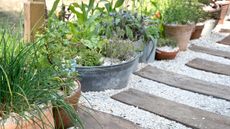Landscaping
Landscaping ideas for the perfect paving, fencing, patio and driveway solutions
Latest
-

Don't neglect this simple task if you want to avoid snow mold ruining your lawn, say the experts
Landscaping Allowing debris and organic matter to build up on your lawn helps provide the perfect conditions for damaging snow mold, so get out the sweeping brush now
By Jayne Dowle Published
-

10 beautiful, low-maintenance xeriscape ideas to recreate at home
Ideas Try these xeriscape ideas to transform your yard into an easy-care, low-water landscape
By Zia Allaway Published
-

When is the best time to apply lime to a lawn? These experts offer their advice
Landscaping Find out when to apply lime to a lawn so you can enjoy healthy grass in spring and summer
By Anna K. Cottrell Published
-

Will King Charles still have time for his secret gardening skill now he's the monarch?
Gardens The new King is patron of the UK’s National Hedgelaying Society and has laid miles of hedgerow around his Highgrove estate. But will he still have time now he’s on the throne?
By Jayne Dowle Published
-

When is the best time to aerate a lawn? Experts give the definitive answer
How To Find out when to aerate a lawn so you can keep your turf in peak condition and ensure plenty of healthy new growth
By Anna Cottrell Published
-

Xeriscaping: this landscaping technique will transform the way you garden
Landscaping Discover xeriscaping and create a beautiful, easy-care, environmentally-friendly yard that will save you money
By Zia Allaway Published
-

Lawn care for winter: how to look after grass throughout the colder months
How To These tips on lawn care for winter will help keep your turf healthy despite inclement weather
By Holly Crossley Published
-

Cheap DIY garden path ideas: 10 ways to build a path for less
Ideas These cheap DIY garden path ideas prove you don’t have to spend a fortune to make an impact on your outdoor space
By Jayne Dowle Published
-

Landscaping with lights: 16 enchanting ways to illuminate your space
Ideas Landscaping with lights will transform any backyard into a dramatic and atmospheric nighttime scene
By Holly Crossley Last updated
-

DIY deck ideas: 10 stylish projects to update your outdoor living space
Ideas These DIY deck ideas will breathe new life into your plot for an affordable price
By Holly Crossley Published
-

Concrete paving ideas: 12 sturdy and stylish designs for your yard
Ideas These concrete paving ideas will help you create stunning patios and pathways for cheap
By Holly Crossley Published
-

Concrete patio ideas: 11 poured, paved and polished concrete floors for modern plots
Ideas These concrete patio ideas are perfect for achieving an on-trend and industrial look for your outdoor space
By Holly Crossley Last updated
-

How to stop deck paint from peeling: expert tips to stop this common problem
How To Find out how to stop deck paint from peeling and yours will soon be looking as good as new again
By Sarah Wilson Published
-

Front yard fence ideas: 11 beautiful boundaries for your home
Ideas These stylish front yard fence ideas are perfect for defining your plot and making a good first impression
By Holly Crossley Published
-

Should you ditch your grass for drought-tolerant clover? The experts discuss
Landscaping This alternative to the traditional lawn might be more suitable to grow as we face further heatwaves
By Jayne Dowle Published
-

DIY landscaping ideas: 10 show-stopping projects to update your plot
Ideas Our round-up of DIY landscaping ideas are easy, budget-friendly, and stylish – from paths to pretty patios and more
By Holly Crossley Published
-

How to treat a deck: our easy guide explains everything you need to know
How To Find out how to treat a deck and make sure yours looks its best all year round, whatever life might throw at it
By Sarah Wilson Published
-

When to water after applying weed and feed: top tips for your turf
How To Get the greenest of grass by learning when to water after applying weed and feed
By Holly Crossley Published
-

How often to fertilize a lawn: a simple guide on when to feed garden grass
How To Wondering how often to fertilize a lawn? With help from the experts, we explain when to do this essential outdoor task
By Holly Crossley Published
-

Block paving ideas: 10 ways to use this versatile surface in your outdoor space
Ideas Block paving ideas are not just for driveways. Use them for patios, paths, porches and more to create a unique look
By Sarah Wilson Published
-

How to clean artificial grass quickly and easily: top tips from the experts
How To Learn how to clean artificial grass and keep your lawn looking fresh all year
By Flora Baker Published
-

How to lay stepping stones on grass: 4 easy steps for a stylish garden path
How To Learning how to lay stepping stones across your lawn will help protect your turf in style
By Holly Crossley Published
-

What is permeable paving? Find out all you need to know with our expert advice
Landscaping If you're wondering 'what is permeable paving' and why you should choose it, our expert guide has all the answers to your questions
By Sarah Wilson Published
-

Above ground pool landscaping ideas: 9 ways to fit these features into a backyard
Ideas From sleek decks to tropical-inspired schemes, these above ground pool landscaping ideas are sure to inspire
By Holly Crossley Published
-

Landscaping with roses: 9 expert ways to use these blooms in your space
Landscaping Our top tips on landscaping with roses reveal how to achieve the most amazing planting schemes in your own garden
By Teresa Conway Last updated
-

Landscaping with pebbles: 14 creative ways to use them in your yard
Landscaping There's always a place for landscaping with pebbles as they slot right in whatever your style of garden design
By Sarah Wilson Published
-

The new eco option for garden paving
If you want to go greener when it comes to choosing paving for your garden here’s all the design inspiration and expert information you need to make the right choice
By Sarah Wilson Last updated
-

Choose a beautiful new look for your summer decking project
If you're looking for ideas to renovate your outdoor space with smart new decking you'll love these inspirational looks
By Sponsored Last updated
SPONSORED -

How to clean landscaping rocks: simple steps for sprucing up the stones in your plot
How To Our tips on how to clean landscaping rocks will get these statement features looking as good as new
By Holly Crossley Published

